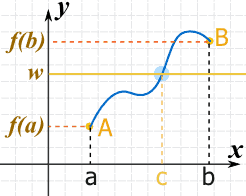Intermediate Value Theorem algebra homework help
Intermediate Value Theorem
On page 193 of the textbook, the intermediate value theorem is discussed. For the intermediate value theorem why do you think it is necessary for the signs of f(a) and f(b) to be different in order to guarantee there is a zero between a and b.
The following link may be helpful:
https://www.mathsisfun.com/algebra/intermediate-va…



The curve from A to B is the function y = f(x)
As a matter of fact, the signs of f(a) and f(b) must be different for a zero to exist between a and b i.e. f(a) will be below zero (negative), while f(b) is above zero (positive). This way, since the curve is continuous, somewhere in between it will be able to cross through y = 0. Consider an example;
y = x4 – 2x2 – 3 = 0
Let’s determine whether there exists a solution between x = 0 and x = 3
At x = 0;
y = x4 – 2x2 – 3
y = (0)4 – 2(0)2 – 3
y = -3
At x = 3;
y = x4 – 2x2 – 3
y = (3)4 – 2(3)2 – 3
y = 81 – 18 – 3
y = 60
Clearly at x = 0, y = -3, which is below 0 – meaning the curve is below zero; at x = 3, y = 60, which is above 0 – meaning the curve is above zero.
Since x4 – 2x2 – 3 is a polynomial, the curve will be continuous, thus a point in between it has to cross through y = 0.
The above example justifies our assertion.
If it is the case that the signs of f(a) and f(b) are the same, does that mean the function f(x) cannot have a zero between a and b?
Yes
Explain.
If say both f(a) and f(b) are negative, since A is the lowest point and B is the highest point it means that both f(a) and f(b) are below zero, thus there is no way a zero can be between a and b. Similarly, if both f(a) and f(b) are positive, both f(a) and f(b) are above zero, hence there is no way a zero can be between a and b.
I need help with the question below.
For the last question to get a clear example of why we can still have a zero consider the following situation: let f(x) = x2-2 and a = -3 and b = 2. What are the values of f(a) and f(b)? Are the signs of f(a) and f(b) different? Use the techniques you know from this class to find the zeros of f(x). Are the zeros between a and b? What does this say about the possibility of zeros even if the conditions of the IVT do not hold?
Do you need a similar assignment done for you from scratch? We have qualified writers to help you. We assure you an A+ quality paper that is free from plagiarism. Order now for an Amazing Discount!
Use Discount Code "Newclient" for a 15% Discount!
NB: We do not resell papers. Upon ordering, we do an original paper exclusively for you.


